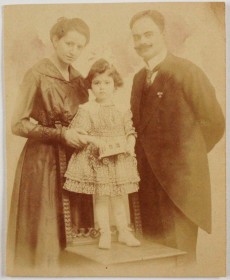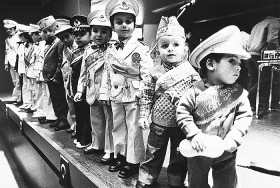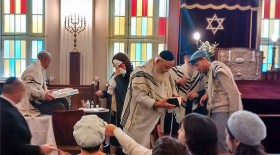Shortly after the opening of our temporary exhibition “Snip it!”, the Jewish Museum received as a bequest the estate of Fritz Wachsner (1886 – 1942). Included in this delivery was a bundle of letters so enormous that I didn’t have time, in creating an inventory, to delve into each individual piece. But one letter caught my attention. “[…] Your assessment of the circumcision issue […]”, wrote Wachsner on 24. July 1919 to his – then very pregnant – wife Paula’s uncle Anselm Schmidt (1875 – 1925). I read on and suddenly found myself in the middle of a nearly one-hundred-year-old internal Jewish debate on circumcision.

Fritz Wachsner with his wife Paula and their first-born child, Charlotte, studio portrait, ca. 1916 © Jewish Museum Berlin, photo: Jörg Waßmer, Gift of Marianne Meyerhoff
At the time, Fritz Wachsner was 33-year-old teacher in the town of Buckow in Brandenburg. In the five-page letter he clarifies the reasons for his hostile stance towards the Bris. He was an assimilated German Jew and belonged to a Reform Jewish congregation. As he explains to his uncle, he was “raised fairly orthodox” but, in the course of his university studies in Berlin and Jena as well as at the Academy for the Study of Judaism in Berlin, he learned “to know and appreciate the spirit of Judaism freed from every non-German embellishment”. He became persuaded that the religion should evolve continually and be “modernized and improved”. Wachsner’s maxim was: “Become German, outside as well as inside the religious community”, the overtones of which are especially → continue reading
In some families the subject of circumcision provokes intense discussion, as you can see in the films that are part of our special exhibition “Snip it! Stances on Ritual Circumcision”. Oliwia is familiar with this difficult situation: on the one hand her Muslim husband considers it a natural part of the tradition, and on the other, particularly her Catholic father argues vehemently against it. Should she have her four-year-old son circumcised? What does she think of the practice herself? We spoke about these questions with Oliwia, as well as about her final decision.
Oliwia*, what different factors affected your family’s conflict over whether to circumcise your son?

“Boys before their Circumcision”, photo from the series “Turkish in the Ruhr district”, Cologne, 1983 © Henning Christoph / Soul of Africa Museum
My husband is Moroccan and Muslim. My background is Roman Catholic, although I converted to Islam in 2006. We had a son four years ago and from the beginning it was clear for my husband that Jamal would be circumcised. It’s a part of the tradition for him and it symbolizes a man’s identification with Islam.
It wasn’t so clear for you?
No. Actually, I’m → continue reading

“A ceremony with friends and family”: The bris of Jaal, photo: William Noah Glucroft
In the last few weeks at “Blogerim” we have reported on the discussions that the subject of circumcision can prompt. We shouldn’t lose sight, though, of the fact that the ritual is a matter of course for most Jewish and Muslim families – as, for example, for Amitay and Meital from Israel. I asked the couple what their son Yaal’s bris was like for them.
In mid-December you had Yaal circumcised by a mohel at the Fraenkelufer Synagogue. Did you have to think about it for a long time?
Meital: For me, there was no question.
Amitay: Same here. But when the time approached, I did have some questions.
→ continue reading


